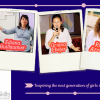SparkDigiGirls - Lithuania
The recent push to tackle gender disparities in areas such as STEM and ICT is more than a question of justice or fairness in access to the industry in these male-dominated fields, as important as those concerns may be. Projects that may shine a light on the factors that keep women, particularly young women, from pursuing careers in digital technologies (as well as best practices to tackle gender disparities) are crucial to ensure that the field is able to fully provide the solutions to the issue.
SparkDigiGirls aims to encourage girls to explore digital technologies such as AR (Augmented Reality), AI (Artificial Intelligence) and other technologies to come up with new and interesting ideas.
Why is SparkDigiGirls necessary?
In primary school, boys and girls are almost equally likely to want to work in a science-related field. However, in subsequent school years girls' attitudes and opinions are changing and they are more likely to choose careers in social, environmental, and medical fields over science, technology, engineering, and mathematics (STEM) and ICT studies. This is due to biases, lack of role models, mentoring and other reasons that limit girls' ability to fully benefit from the opportunities offered by digital transformation.
According to the 2021 data of Eurostat, girls and women continue to be under-represented, being only 19.1% of all ICT students in the EU. Among the four countries of focus of SparkDigiGirls Project, Lithuania had the highest rate of women in ICT - 23,7%. Greece and Portugal displayed, respectively, 21,3% and 20,7%, with Slovenia being the lowest, with 16,6%.
Gender stereotypes are persistent, as are misconceptions related to working in technology and engineering. Teachers and educators can play an important role in changing this perspective by giving girls guidance and access to experiences that can change the current scenario (Marques, et al. 2022). In view of this need, partners from Lithuania, Portugal, Slovenia, and Greece initiated the two-year international project SparkDigiGirls, funded by Erasmus+ strategic partnership in the field of youth.
Get to know the initiative
The project Empower Girls Creativity Through Use of Digital Technologies (SparkDigiGirls) aims to encourage girls to explore digital technologies such as AR (Augmented Reality), AI (Artificial Intelligence) and IoT (Internet of Things) and to come up with new and interesting ideas, using their newly acquired digital knowledge to contribute to the STEM industry (dominated by men) with innovative, different, and creative approaches.
The project seeks to fulfill specific objectives:
- reduce girls’ concerns and demystify existing stereotypes about computer science and technology;
- increase of digital literacy skills for girls to open new and unforeseen possibilities for creativity, participation of girls in the digital world;
- empower youth workers as mentors to pursue girls creativity through usage of digital applications and increase attractiveness of digital sector among girls.
The project is organized in following elements:
- a twofold analysis of ways how innovative and new technologies may develop creativity of girls was completed;
- curriculum which meeting girls' needs and leads to improvement and increase of their creativity through usage of innovative applications/digital tools was prepared.
- online programme focused on use practical experiential learning model and real life tasks that allow girls to explore technologies and come up with new and exciting ideas and solutions for given problems was developed.
- digital female role model campaign was accomplished
Why is this a good practice?
The project SparkDigiGirls started by surveying more than 30 case studies identified in each of the countries, followed by interviews with their representatives. This allowed the identification of the topics in ICT and technologies that might interest girls. An online program was created, using the LMS moodle platform.
The online program contains 16 separate learning packages called challenges. Each challenge covers a specific topic or area of interest of young girls age 14+. For example, fashion, design, environment, culinary, art, etc.
Each challenge includes two essential intertwining components: digital technologies and and real-life situations or problems that young girls face in their lives. 279 girls participated in pilot training and 40 youth workers of the learning materials.




